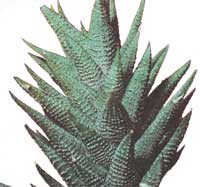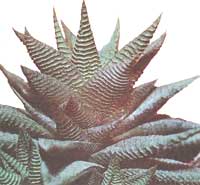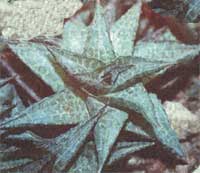Haworthia / Haworthia
Refers to the family of the lily. Fatherland - South Africa.
General description: Haworthia is a very popular and unpretentious succulent. It is distinguished by a beautiful basal rosette of stiff, fleshy narrow and long pointed leaves. Flower stalks are usually cut, as if flowers do not have any decorative value.
Usually in the room conditions the following species are bred:
Haworthia margaritifera (Havortia pearly). It has leaves 7-8 cm long, inconsistently covered with snow-white pimples. Blossoms with a nondestructive racemose inflorescence on a long peduncle.
Haworthia fasciata (Haworthia striped). Its leaves are longer and sharper, pimples are smaller, but are thicker and form rows.
Haworthia tesselata (Havortia chess). Its leaves are large and short, approximately triangular, with jagged edges. Only the lower side of the leaves is pimpled, the upper side has a translucent mesh of light strips.
Haworthia reinwardtii (Haworthia Reynwardt) is an exception among Haworthia, as if it does not form a rooted outlet, but owns a stem up to 20 cm high, covered with thick triangular leaves.
Recommendations for the care of the plant Havortia:
Illumination : photophilous, shading is needed only in the summer noon.
Irrigation mode : Moderate, by the measure of drying of the soil. In the winter, outlandish.
Humidity of air : Haworthia is not demanding at all for the humidity of the atmosphere, but in winter, periodic spraying is desirable in a warm place.
For the summer it is better to place on a fresh atmosphere (in the park or on the balcony).
Temperature regime : 18-20 ° С in summer, in winter the period of inactivity is 10-12 ° С, minimum 5 ° С.
Soil: Good drainage is required. You can add small gravel or expanded clay.
Recommended soil mishmash: 1 share of clay-turf ground, 1 share sheet, 1 share of sand.
During the growth period, one needs fertilizing once per moon with fertilizers for cacti and succulents. Needs increased potassium content.
Breeding : Daughter rosettes and dried leaf cuttings.
Transplant : Transplanted in the spring, annually. The root system is superficial, so the pot must be wide, but not deep at all.
Pests : It is affected by aphids (they form sticky excretions on shoot tips, buds), mealybugs (covered with snow-white cotton wool).
The plant is allowed to help finish with a soap solution, warm washing and spraying with an actinic (1-2 ml per liter of water).




Haworthia pearliferous - haworthia margaritifera
Haworthia striped - haworthia fasciata
Haworthia reinwardtii
Haworthia limifolia - haworthia limifolia
Haworthia chess - haworthia tesselata


Comments
When commenting on, remember that the content and tone of your message can hurt the feelings of real people, show respect and tolerance to your interlocutors even if you do not share their opinion, your behavior in the conditions of freedom of expression and anonymity provided by the Internet, changes Not only virtual, but also the real world. All comments are hidden from the index, spam is controlled.